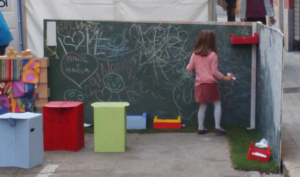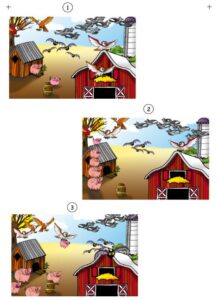Can we measure creativity in the early years – and so better understand its origins?
Creativity is increasingly recognised as important in education, but many questions and misconceptions remain. For example, how can creativity be assessed? How does it relate to students’ competencies and interests? And why do children differ in creativity? Our research aimed to provide new insights into these fascinating questions.
Creativity means many things
In everyday conversations, creativity is discussed in various contexts. Most often, we use the word ‘creative’ to describe individuals, behaviours, and products. Generally, we have a rough idea of what we’re referring to when talking about creativity, but the task becomes more difficult when we want to define the term more precisely.
How would you describe creativity? Would you say that it is related to behaviours that are associated with certain areas of expertise, such as arts? Or would you say that creativity relates cognitive processes, such as creative problem solving? Or is it something to do with being uninhibited and eccentric?

source: Helenina
Most commonly, in the research literature, creativity is defined as a production of something that is original and appropriate. This broad and vague definition reflects the multidimensional and complex nature of creativity.
The complexity of creativity poses problems for research. Diversity in definitions means diversity in measures. This is not a problem per se but must be acknowledged if we want to understand creativity in real life settings, such as education. For example, very different interventions would be needed in schools, if creativity is conceptualised as artistic behaviours vs. ability to come up with a creative solution for an ill-defined problem. These different dimensions of creativity may be related, but currently we don’t have a good understanding of this possible relationship. Time and again, research has reflected this problem by indicating that commonly used cognitive measures of creativity are not good predictors of creative achievements and behaviours. In other words, performing well in cognitive creativity tests does not yet tell us much about ‘real-world’ creativity.
One way to tackle different questions about creativity is by using Margaret Boden’s concepts of Psychological and Historical creativity. Psychological creativity refers to creative insights which we experience throughout our life. These ideas are new to the person who comes up with them but not unique since they are experienced by others as well. In contrast, Historical creativity refers to eminent achievements, which are rare occurrences in human history. However, Historical creativity can be viewed as a special case of Psychological creativity and may rely on similar cognitive processes. Therefore, it is possible to investigate how Historical creative achievements come about and how to increase them via studying Psychological creativity. In our study we investigated one aspect of Psychological creativity in children – expressive writing – to gain insights into creative processes.
Telling stories is a way to express creativity
Our study addressed 3 research questions: (1) whether creativity can be measured in childhood storytelling at age 9; (2) whether creativity in storytelling is linked with other educationally relevant constructs of academic achievement, intelligence, and motivation; (3) how strong the influences of genetic and environmental factors on childhood creativity are.
The written stories were based on three cartoon images, describing a day at a farm (see below). Stories are a great way to estimate creativity in primary education since language is a medium available to most children and does not require many resources. However, this does not mean that everyone necessarily wants to engage with language creatively. Children are only likely to engage creatively with storytelling if they find it interesting and enjoyable (are intrinsically motivated to do it). The relationship between motivation and creativity has been reported in creativity research. In fact, intrinsic motivation may be involved in the transformation from Personal to Historical creativity as most eminent creative achievements require plenty of time and personal sacrifices. Children’s stories in our study were evaluated on their creativity, as well as nine other dimensions related to creativity, by a group of judges (Psychology students in this case). This method, called the Consensual Assessment Technique (CAT), is commonly used to evaluate creativity of products, such as paintings, music, and stories. The method relies on judges’ subjective evaluations on what a creative product is. The judges are not instructed on how to evaluate the stories on creativity but are asked to rely on their subjective assessment which story is creative, and which is not. The use of this method has demonstrated that judges agree strongly on which stories are creative, even when no specific criteria for the evaluation is given.
Children’s stories in our study were evaluated on their creativity, as well as nine other dimensions related to creativity, by a group of judges (Psychology students in this case). This method, called the Consensual Assessment Technique (CAT), is commonly used to evaluate creativity of products, such as paintings, music, and stories. The method relies on judges’ subjective evaluations on what a creative product is. The judges are not instructed on how to evaluate the stories on creativity but are asked to rely on their subjective assessment which story is creative, and which is not. The use of this method has demonstrated that judges agree strongly on which stories are creative, even when no specific criteria for the evaluation is given.
In our study there was also a very high agreement on creativity assessment among the independent judges. Stories that were scored as more creative were also rated higher on imagination, emotionality, and novelty. Based on this finding, we created a composite score of Creative Expressiveness for each story that was used to investigate the relationship of creative content to other educationally relevant measures.
Creative Expressiveness at age 9 was associated with intelligence, motivation to write, and English grades at the same age – consistent with previous findings. We also found a small association between Creative Expressiveness at age 9 and English grade at age 16. This relationship seems to have emerged over time and was present even when we statistically removed associations with English grades at ages 9 and 12. This result may indicate that creative content in writing is not incorporated in English writing grades until later school years.
The results suggest that creative skills of students at a young age may get overlooked, as emphasis is usually on technical writing skills. Undervaluing these creative skills and focusing on grammar or spelling skills may turn some students away from creative writing to the detriment of their later schoolwork. Reflecting on this point, focusing on creative storytelling alongside technical language skills from a young age may enhance motivation and future achievement.
Creativity is not fixed at birth
A common misconception of creativity is that it is fixed at birth, determined by our genes. This is incorrect for several reasons. First, genetic influences on human behaviours, such as creativity, intelligence, and motivation, are complex and dynamic: many genes are involved and their influences change over time. In other words, different sets of genes may be contributing to a particular behaviour at different points of our lives. Second, the way our genes work changes depending on our life circumstances and experiences – genes and environments interplay. Therefore, a genetic profile at birth cannot be used to predict the level of one’s creativity later in life.
Twin studies can help us understand the extent to which individual differences in creativity can be attributed to genetic or environmental influences at a particular age in a particular population. Participants in our study were identical or non-identical twins taking part in the longitudinal Twins Early Development Study (TEDS), representative of the population of England and Wales.
Identical twins share 100% of their DNA, whereas non-identical twins share no more of their DNA than any two siblings (50% of their segregating DNA on average). From comparing the similarities (correlations) in creativity between identical and non-identical twin pairs, we can conclude the relative importance of genes and environments to this trait. For example, if identical twins are more similar to each other (on average) than non-identical twin pairs, we know that genetic influences play a role in the development of the trait.
Our results showed that the correlation for the Creative Expressiveness score was .55 among identical twins, and .38 among non-identical twins. This indicates that the shared genetic make-up of identical twins played a role in how similar their stories were in creative expressiveness. The role of environments in creativity in childhood was also substantial: 2/3 of the variance in creativity was due to family-wide and individual specific environments. Further statistical analyses showed that a third of the differences in creativity can be attributed to genetic effects. The rest is due to various environmental influences. These results demonstrate that creativity, like most human traits, is not fully determined by environments or genes. Instead, people differ in it for a host of reasons. What twin studies are not able to tell us, is what these specific creativity enhancing environments and genes are.
Further analyses of our data also showed that the associations between most measures, such as between creativity and intelligence, were mainly due to shared genetic effects. This overlap in genetic influences between creativity and other measures indicates that the genetic architecture of creativity is intertwined with other psychological constructs.
Implications to educational practice
Our results have several potential implications for educational practice. First, we established that creativity can already be measured in the early school years through use of the CAT. Second, the study demonstrates that storytelling is an accessible way to express creativity which can be incorporated easily in educational practices. Third, environments have more influence on childhood creativity than do genetic effects. Further research is needed to identify what specific environments are involved. Fourth, creativity is not a clear-cut construct but overlaps with other psychological constructs, including at the genetic level.


Leave a Reply